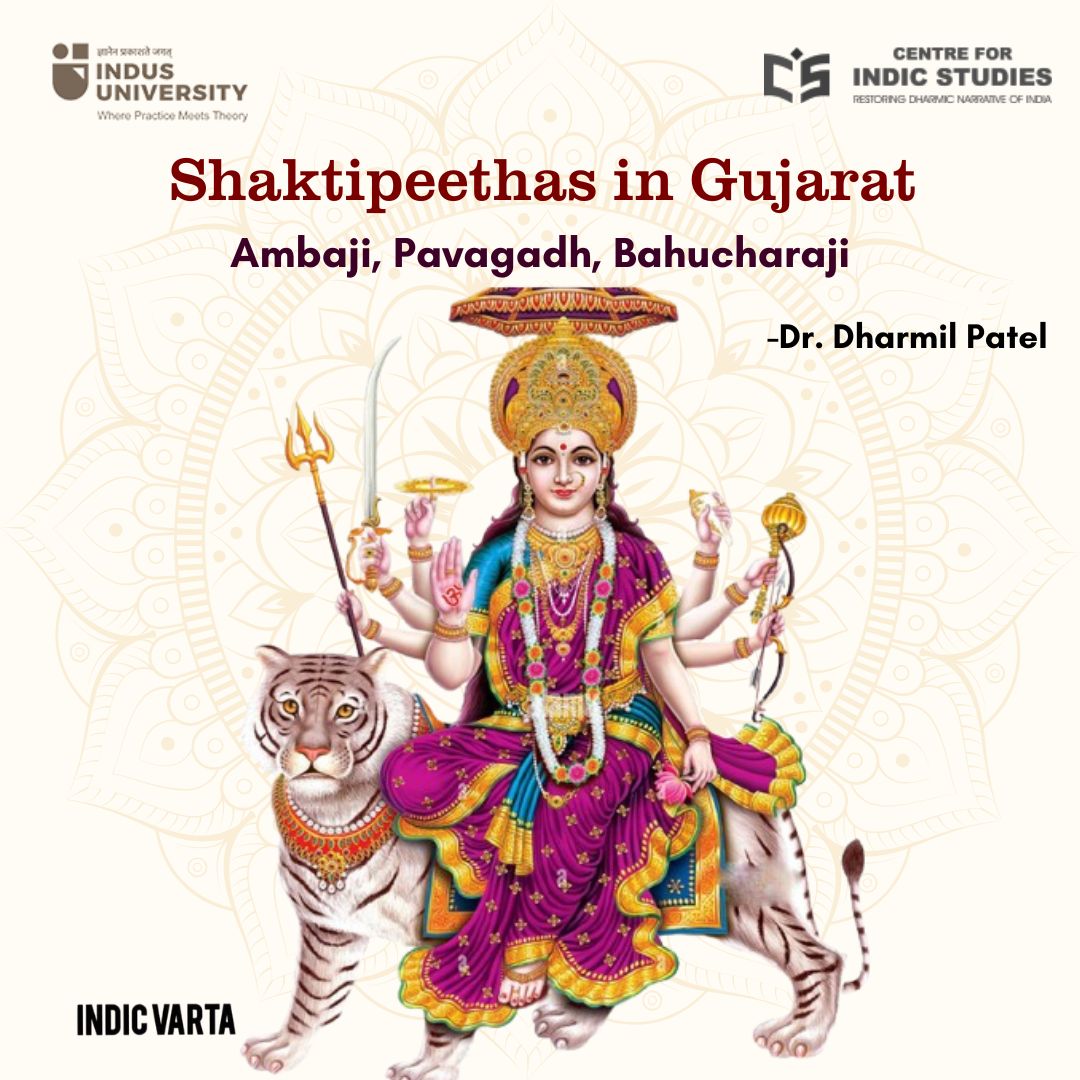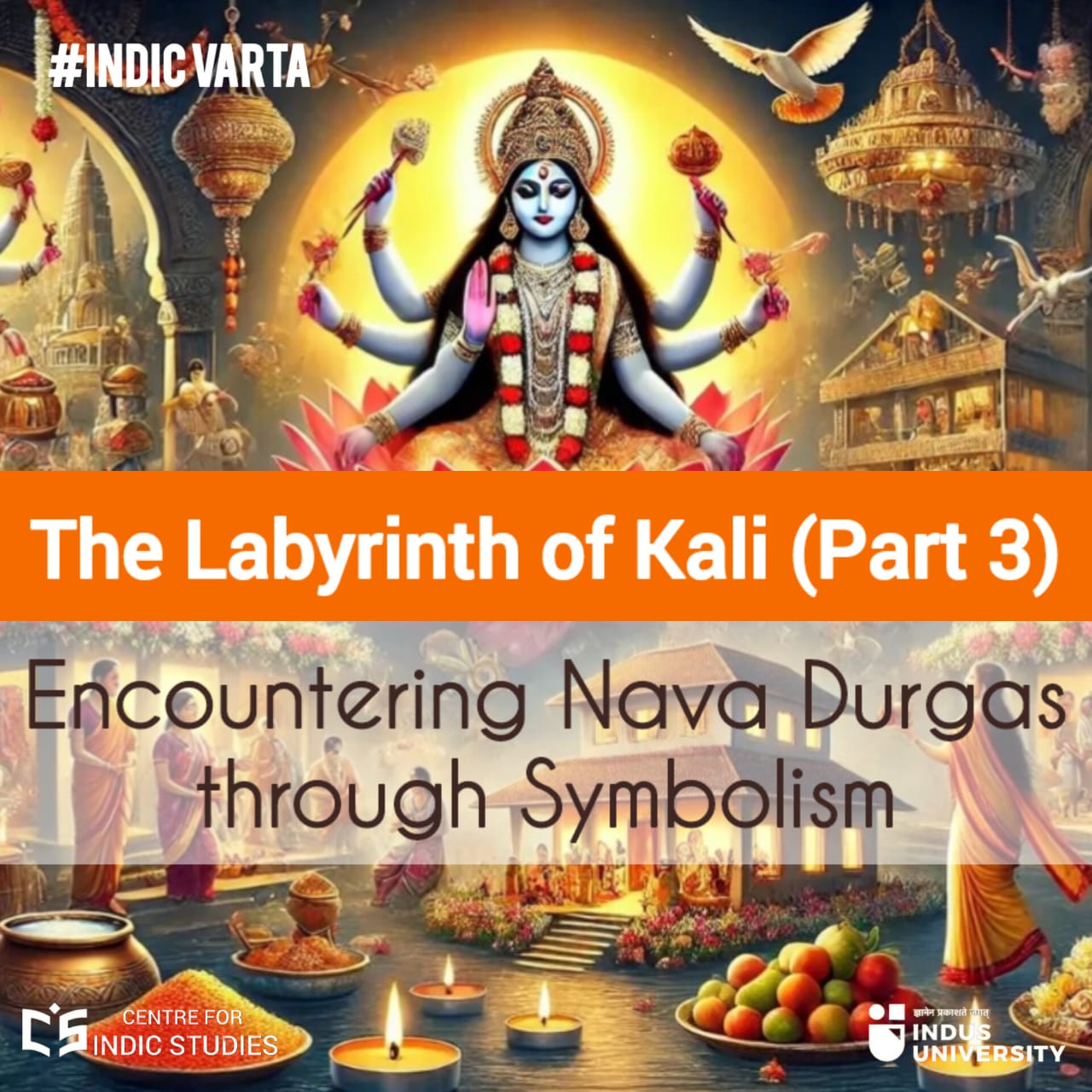- Visitor:114
- Published on: 2024-10-11 12:56 pm
The Story, Symbol, and Significance of Siddhidātrī
She represents a beautiful fusion of grace and strength that femininity upholds. As she bestows the eight siddhis, she symbolizes spiritual as well as materialistic prosperity. It is to be noted that whereas she could have vanquished the demons herself, she chose to empower the deities and fight the demons as a team— showcasing the pinnacle of leadership. She symbolizes that when women embrace their feminine self, they not only become qualified achievers, but also the best of leaders in any given field.

Story
When the evil rises to the shore,
The devatās knocked at devī’s door:
She redeemed their long-lost glory
As I narrate those in my story.
The goddess, divine and motherly, has incarnated time and again in as many forms as imaginable! Whenever the nefarious forces surmount the apogee and every nook and corner of auspice wails in trauma, the devī appears to annihilate the former and preserve the latter. Whenever the asuras assailed the heaven, the devatās were saved by the devī who slaughtered the demons to revert to the status quo. She is invincible in battles and she also empowers her children. She is called Siddhidātrī because she bestows all forms of siddhi to the devotees.
The story of Siddhidātrī is found in several Purāṇas. According to the legends, the universe was once plagued by demons who disrupted the balance of creation. These demons, fuelled by their ignorance and arrogance, created chaos, threatening the stability of the cosmos. In response, the deities convened and realized that only a powerful force could restore order. To combat the evil forces, the deities prayed fervently to the divine feminine. In response to their devotion, the divine energy manifested as Durgā, who took on multiple forms to confront the demons. Among these manifestations was Siddhidātrī, embodying the ultimate spiritual power. Siddhidātrī seats upon a lotus. She has four arms, holding śaṅkha (conch shell), cakra (discus), gadā (mace), and padma (lotus). As the battle between the deities and the demons raged on, Siddhidātrī emerged as a beacon of hope. With her immense power, she granted the deities the eight siddhis, empowering them to defeat their foes. These siddhis are: aṇimā (reduction to miniscule), mahimā (expansion to enormity), laghimā (loosening weight), garimā (turning heavy and dense), prāpti (attainment), prākāmya (access to all corners), īśitva (dominion over materials), and vaśitva (influence over others). Each of these powers represented a unique aspect of spiritual attainment, such as control over elements, mastery of the mind, and the ability to influence the course of events—all of which helped the deities to regroup. The climax of the story occurs when she confronts the most powerful demon, Mahiṣāsura, known for his invulnerability. Utilizing her divine energies and the siddhis she had bestowed upon the deities, Siddhidātrī orchestrated a strategic attack. With her guidance, the deities united their strengths, combining their newfound powers to vanquish the demon. This victory restored balance and harmony to the universe.
Symbol
Not just the story, but the very figure of Siddhidātrī is filled with symbolism. For instance, the conch shell represents the sound of the divine and the call to awaken one’s inner self. The discus signifies the power of the mind and clarity of thought. The mace represents strength and protection, while the lotus embodies spiritual growth and enlightenment. Lotus being her divine seat suggests that she is as calm and composed in the face of adversity as she is while offering boons.
She represents a beautiful fusion of grace and strength that femininity upholds. As she bestows the eight siddhis, she symbolizes spiritual as well as materialistic prosperity. It is to be noted that whereas she could have vanquished the demons herself, she chose to empower the deities and fight the demons as a team— showcasing the pinnacle of leadership. She symbolizes that when women embrace their feminine self, they not only become qualified achievers, but also the best of leaders in any given field.
Significance
One of the most significant benefits of worshipping Siddhidātrī is the potential to attain various siddhis, such as clairvoyance, healing, and mastery over the elements. Devotees believe that sincere devotion and practice can help them harness these powers, leading to enhanced capabilities in personal and spiritual endeavours. She is often seen as the granter of wishes (icchā). Devotees approach her with specific aspirations— be they related to career (karmasiddhi), relationships (saṃbandhasiddhi), or personal growth (ātmavikāśa). Her divine grace is believed to manifest these desires, helping individuals achieve their goals. Worshipping Siddhidātrī fosters a profound sense of inner strength (śakti) and resilience. By invoking her energy, devotees cultivate self-confidence and the ability to face challenges head-on. This empowerment is crucial for personal growth, enabling individuals to navigate life's difficulties with grace. She represents the pinnacle of spiritual attainment (mokṣa or siddhi). Her worship encourages practitioners to delve into their inner selves, promoting self-awareness (svayamaprakāśa) and enlightenment (jñāna). Devotees often experience a deeper connection to their spiritual essence, guiding them on their path toward self-realization (ātmasākṣātkāra). Many devotees seek Siddhidātrī’s protection (rakṣā) from negative energies (pāpakarma), evil forces (asura), and other harmful influences. Her divine presence is believed to create a shield of spiritual energy that safeguards individuals and their environments, allowing them to cultivate a harmonious atmosphere. Worshipping Siddhidātrī contributes to physical and mental well-being. The act of prayer (prārthanā), meditation (dhyāna), and rituals (saṃskāra) associated with her worship promotes relaxation and reduces stress, anxiety, and dementia, leading to improved mental health. In times of uncertainty, devotees often turn to Siddhidātrī for guidance. Her wisdom (prajñā) and nurturing energy provide clarity and direction, helping individuals make informed decisions (saṅkalpa). This guidance can be particularly beneficial during transitions or challenging life situations. Ultimately, Siddhidātrī serves as a guiding force, illuminating the path toward self-realization and mastery of one’s inner potential, helping individuals navigate the complexities of life with strength and grace. Therefore, you should seek siddhi from Siddhidātrī by chanting:
सिद्धगन्धर्वयक्षाद्यैरसुरैरमरैरपि ।
सेव्यमाना सदा भूयात् सिद्धिदा सिद्धिदायिनी ॥
विद्या: समस्तास्तव देवि भेदा:
स्त्रिय: समस्ता: सकला जगत्सु।
त्वयैकया पूरितमम्बयैतत्
का ते स्तुति: स्तव्यपरा परोक्ति:।।
या देवी सर्वभूतेषु माँ सिद्धिदात्री रूपेण संस्थिता।
नमस्तस्यै नमस्तस्यै नमस्तस्यै नमो नमः।।
।। ॐ सिद्धिदात्र्यै नम: ।।
- 57 min read
- 2
- 0










